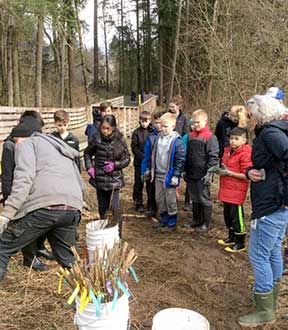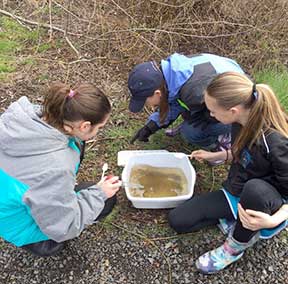 |
Previous Issues |
| Cedar Mill Community Website |
|
Search the Cedar Mill News: |
About The Cedar Mill News |
|
|||||||
| Volume 15, Issue 7 | July 2017 |
||||||
The Cedar Mill Wetlands and What We Did
|
||||
 |
Penny Patrick & Dan Shedden teach sixth graders at Springville K-8. Penny explains, “Due to overcrowding, we were at the Timberland site this year. Our sixth graders are studying water: our big question is ‘How does water quality affect the ecology of a community?’”
“The class planted trees and shrubs at the Cedar Mill Wetland. Frank Reed, from the TVWD, gave a presentation and we took field studies to the Clean Water Services site as well as Hagg Lake and the Joint Water Commission site.
“We'd like our kids to inform the community about their learning, and maybe even teach people about our water—where it comes from and how we can be sure we're protecting this valuable resource.”
When the Springville K - 8 6th graders went to the Cedar Mill Wetlands on our field study, we planted trees, did an observation and studied micro and macro invertebrates. We walked from Timberland Middle School to the Cedar Mill Wetlands.
 |
We planted Indian Plum, Cascara, Thimbleberry, Red Elderberry, Snowberry and Slough Hedge. We planted in the Cedar Mill Wetland to help stop erosion, grow more native species, and slow water in the area. There were sticks with colored tape around them; the different colors were representing different plants. Ms. Schweitzer from Clean Water Services came and helped us plant.
When we did our observation, we had to sit for 20 minutes silently and make notes on what we were observing. We took notes on what we saw, what we heard, what we felt, and any more questions, notes, or details. For my observation, I found a pine cone. It was yellowish-green and had multiple layers. When I was doing my observation, we were next to a road so I heard cars.
We looked at macro and micro invertebrates in the wetland pond water. We tried to identify what living organisms they were by their shape, if they looked fuzzy, or they had antennas. The difference between macro and micro invertebrates are that macro means that you can see them with your eye and micro means that you can only see them with a microscope.
The sixth graders would like to go back to the Cedar Mill Wetlands to see how much the plants have grown since we planted them. We want to see if there are different macro and microinvertebrates in the wetland pond in the different seasons.
Visit the class website to see more photos!
![]()
Like us on Facebook for timely updates
Published monthly by Pioneer Marketing & Design
Publisher/Editor:Virginia Bruce
info@cedarmillnews.com
PO Box 91061
Portland, Oregon 97291
© 2017